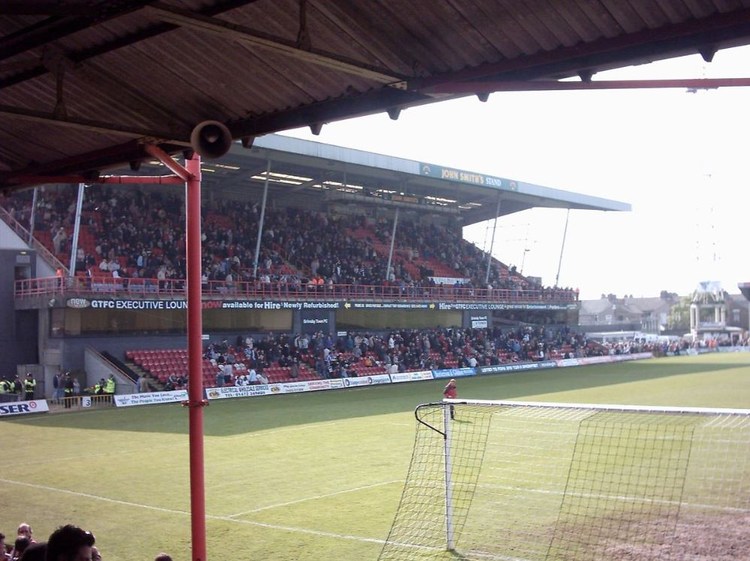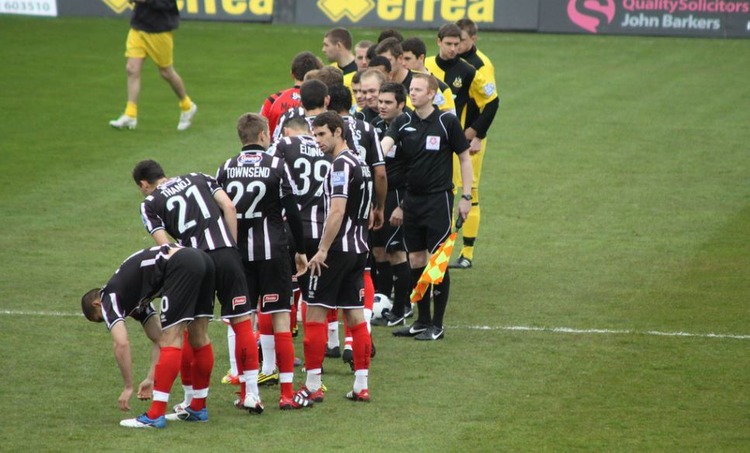League Two Stadiums & Stats

In France they have Ligue 1 and Ligue 2. In Germany, 1. Bundesliga and 2. Bundesliga.
In England we have four different leagues with names that seem to have been given to them for no other reason than to confuse and confound.
League Two is the third division of the football league and the fourth highest league in the country overall.
Get your head around that one.
We’ll try to explain why it’s so strangely named when we discuss the league’s history, as well as tell you how it works nowadays and what sort of stadiums you can expect to encounter should you go on a tour of League Two grounds.
Keep reading!
Stadium Stats
| Stadium | Year Opened | Capacity | Ave Attendance | Record Attendance | Record Attendance Match |
|---|---|---|---|---|---|
|
Alexandra Stadium
Crewe Alexandra |
1906 | 10153 | 4289 | 20000 | Crewe v Tottenham (1960) |
|
Banks’s Stadium
Walsall |
1990 | 11300 | 5540 | 11049 | Walsall v Rotherham 2004 |
|
Blundell Park
Grimsby Town |
1899 | 9052 | 6279 | 31651 | Grimsby Town v Wolvers (1937) |
|
Broadfield Stadium
Crawley Town |
1997 | 6134 | 3106 | 5880 | Crawley Town v Reading 2013 |
|
Community Stadium
Colchester United |
2008 | 10105 | 3586 | 10064 | Colchester Utd v Norwich (2010) |
|
Crown Ground
Accrington Stanley |
1968 | 5450 | 2988 | 5397 | Accrington v Derby (Jan 2019) |
|
Edgeley Park
Stockport County |
1891 | 10841 | 9108 | 27833 | Stockport County v Liverpool (1950) |
|
EnviroVent Stadium (Wetherby Road)
Harrogate Town |
1920 | 5000 | 2296 | 3048 | Harrogate Town v Portsmouth (11/10/2019) |
|
Field Mill One Call Stadium
Mansfield Town |
1861 | 9186 | 6696 | 24467 | Mansfield v Notts Forest (1953) |
|
Gander Green Lane
Sutton United |
1912 | 5032 | 3309 | 14000 | Sutton United v Leeds United (1969) |
|
Globe Arena
Morecambe |
2010 | 6476 | 4572 | 5831 | Morecambe v Sunderland (April 2022) |
|
Holker Street
Barrow A.F.C |
1909 | 6500 | 3492 | 16874 | Barrow v Swansea Town (1954) |
|
Keepmoat Stadium
Doncaster Rovers |
2007 | 15231 | 6500 | 15001 | Doncaster Rovers v Leeds (2008) |
|
Meadow Lane
Notts County |
1910 | 19841 | 8024 | 47310 | Notts Couty v York City (1955) |
|
Peninsula Stadium (Moor Lane)
Salford City FC |
1978 | 5108 | 2831 | 4518 | Salford City v Leeds Utd EFL Cup First Round (2019) |
|
Plough Lane
AFC Wimbledon |
2020 | 9215 | 7662 | 9215 | AFC Wimbledon 3-3 Bolton Wanderers (14/8/21) |
|
Prenton Park
Tranmere Rovers |
1912 | 16587 | 6142 | 24424 | Tranmere v Stoke City (1972) |
|
Priestfield Stadium
Gillingham |
1893 | 11582 | 4967 | 23002 | Gillingham v QPR (1948) |
|
Racecourse Ground
Wrexham A.F.C |
1807 | 10771 | 9973 | 34445 | Wrexham v Manchester United (1957) |
|
Rodney Parade
Newport County AFC |
1877 | 7850 | 4137 | 6615 | Newport v Havant & Waterlooville (2010) |
|
Stadium mk
MK Dons |
2007 | 30500 | 8460 | 30048 | Rugby World Cup Fiji vs Uruguay 2015 |
|
The County Ground
Swindon Town |
1896 | 15728 | 9064 | 32000 | Swindon Town v Arsenal (1972) |
|
The New Lawn Stadium
Forest Green Rovers |
2006 | 5147 | 3148 | 4836 | Forest Green Rovers v Derby County (2009) |
|
Valley Parade
Bradford City |
1886 | 25136 | 18052 | 39146 | Bradford City v Burney (1911) |
Team Stats
| Team | Year Founded | Nickname | Team Owner |
|---|---|---|---|
| Accrington Stanley | 1968 | Stanley, Accy Stanley | Andy Holt |
| AFC Wimbledon | 2002 | The Dons, The Wombles | The Dons Trust |
| Barrow AFC | 1903 | The Bluebirds | Paul Hornby (Local Consortium) |
| Bradford City | 1903 | The Bantams, The Paraders, The Citizens | Stefan Rupp |
| Colchester United | 1937 | The U's | Robbie Cowling |
| Crawley Town | 1896 | The Reds, Red Devils | WAGMI United |
| Crewe Alexandra | 1877 | The Railwaymen, The Alex | Crewe Alexandra Group Limited |
| Doncaster Rovers | 1879 | The Rovers, Donny, Vikings | Doncaster Rovers Limited |
| Forest Green Rovers | 1889 | Rovers, The Green, FGR, The Little Club On The Hill, Green Army | Dale Vince |
| Gillingham | 1893 | The Gills | Brad Galinson |
| Grimsby Town | 1878 | The Mariners, Mighty Mariners, Town | 1878 Partners, Mike Parker, The Mariners Trust |
| Harrogate Town | 1914 | Town, The Sulphurites | Irving Weaver |
| Mansfield Town | 1897 | The Stags, Yellows | Carolyn & John Radford |
| MK Dons | 2004 | The Dons | Pete Winkelman |
| Morecambe | 1920 | The Shrimps, Red and White Army (Now Red and Black Army), Seasiders | Bond Group Investments |
| Newport County | 1912 | The Exiles, The Ironsides, The Port, The County | Newport County AFC Supporters Trust |
| Notts County | 1862 | The Magpies, County, Notts | Alexander and Christoffer Reedtz |
| Salford City FC | 1940 | The Ammies | Class Of '92 Ltd |
| Stockport County | 1886 | The Hatters, County | Mark Stott |
| Sutton United | 1898 | The Us, The Amber and Chocolates, The Yellows | Sutton United Football Club Limited |
| Swindon Town | 1879 | The Robins | Clem Morfuni |
| Tranmere Rovers | 1884 | Super White Army, Rovers | Mark & Nicola Palios |
| Walsall | 1888 | The Saddlers | Trivela Group |
| Wrexham A.F.C | 1864 | Red Dragons, The Robins | Rob McElhenney and Ryan Reynolds |
Ticket Prices
| Stadium | Season Ticket Price (Adult) | Season Ticket Price (Conc) | Season Ticket Price (Junior) | Match Ticket Price (Adult) | Match Ticket Price (Conc) |
|---|---|---|---|---|---|
| Accrington Stanley | £285 - £285 | £227 - £227 | £56 - £119 | £20 - £25 | £15 - £20 |
| AFC Wimbledon | £375 - £550 | £250 - £370 | £40 - £125 | £23 - £35 | £16 - £25 |
| Barrow AFC | £315 - £370 | £255 - £295 | £90 - £105 | £18 - £20 | £15 - £17 |
| Bradford City | £300 - £300 | £260 - £260 | £45 - £190 | £20 - £20 | £18 - £18 |
| Colchester United | £355 - £488 | £248 - £385 | £104.5 - £240 | £21.5 - £30 | £16.25 - £23.5 |
| Crawley Town | £255 - £289 | £170 - £204 | £68 - £85 | £15 - £17 | £10 - £12 |
| Crewe Alexandra | £365 - £365 | £285 - £285 | £55 - £80 | £25 - £27 | £19.5 - £21 |
| Doncaster Rovers | £275 - £345 | £205 - £275 | £20 - £172 | £20 - £21 | £16 - £17 |
| Forest Green Rovers | £323 - £391 | £255 - £306 | £10 - £120 | £19 - £23 | £15 - £18 |
| Gillingham | £350 - £450 | £350 - £370 | £55 - £155 | £22 - £25 | £19 - £19 |
| Grimsby Town | £420 - £475 | £300 - £325 | £125 - £185 | £22 - £24 | £15 - £17 |
| Harrogate Town | £349 - £395 | £285 - £322 | £99 - £169 | £20 - £23 | £16 - £19 |
| Mansfield Town | £315 - £395 | £250 - £315 | £50 - £105 | £21 - £24 | £19 - £21 |
| MK Dons | £386.4 - £4508 | £289.8 - £338.1 | £48.3 - £112.7 | £24 - £28 | £18 - £21 |
| Morecambe | £199 - £319 | £165 - £255 | £50 - £90 | £20 - £25 | £15 - £20 |
| Newport County | £325 - £405 | £305 - £315 | £32 - £190 | £21 - £24 | £19 - £20 |
| Notts County | £347 - £422 | £249 - £271 | £21.5 - £70 | £22 - £24 | £16 - £18 |
| Salford City FC | £250 - £250 | £150 - £150 | £20 - £80 | £15 - £15 | £10 - £10 |
| Stockport County | £435 - £435 | £310 - £310 | £35 - £100 | £22 - £24 | £16 - £17 |
| Sutton United | £359 - £449 | £279 - £369 | £90 - £99 | £21 - £25 | £15 - £19 |
| Swindon Town | £385 - £405 | £295 - £305 | £45 - £140 | £23 - £27 | £20 - £22 |
| Tranmere Rovers | £380 - £480 | £280 - £340 | £102 - £119 | £19 - £22 | £14 - £17 |
| Walsall | £390 - £495 | £295 - £395 | £138 - £310 | £21 - £26 | £18 - £20 |
| Wrexham A.F.C | £340 - £374 | £255 - £289 | £23 - £100 | £22 - £24 | £17 - £19 |
League Two Stadiums

League Two is in a funny place in the English league system. It isn’t close enough to the top for teams to gain promotion and then set about completely revamping their stadium but nor is it so close to the bottom that clubs can have a small capacity and not care that much. As such the types of stadiums you’ll find if you have a look around it are all pretty similar, being as they’re neither the mega-stadia of the Premier League nor the tin-pot one horse buildings you’re more like to find in the National League.
That’s not to suggest that they’re all identical to each other and lack personality, of course. Far from it in fact. There is a real wealth of interesting stadiums to be found in the Football League’s bottom division, with some club’s having fallen from grace, bringing their comparatively large ground with them and others punching above their weight, offering a small and close-knit ground for your appreciation.
The lower reaches of the football league also don’t have to comply with the Football Associations rules for all-seated stadia, meaning that most of them will have at least some section of the ground that is terraced. If you go to League Two clubs with an expectation that comes from having spent a life watching Premier League games then you are sure to be snobbishly disappointed by what you discover. If you head along waiting for a world of individual stadiums full of bags of personality, however, then you’ll be in for a treat.
- Alexandra Stadium
- Banks’s Stadium
- Blundell Park
- Broadfield Stadium
- Community Stadium
- Crown Ground
- Edgeley Park
- EnviroVent Stadium (Wetherby Road)
- Field Mill One Call Stadium
- Gander Green Lane
- Globe Arena
- Holker Street
- Keepmoat Stadium
- Meadow Lane
- Peninsula Stadium (Moor Lane)
- Plough Lane
- Prenton Park
- Priestfield Stadium
- Racecourse Ground
- Rodney Parade
- Stadium mk
- The County Ground
- The New Lawn Stadium
- Valley Parade
About The League

Unlike the Premier League but exactly like the other divisions in England’s Football League, League Two is competed by 24 different teams. Much like with all of the major leagues around Europe, each team plays each other twice, with one game coming at home and one away from home. The team that wins any given match is awarded three points, if the two teams draw then they share a point and the team that loses gets precisely nothing.
At the end of the season all of the points that the team had amassed during the league campaign get added together and teams are given a final place in the league standings. The three teams that finish closest to the top of the table gain automatic promotion to League One. The teams that finish between fourth and seventh, meanwhile, fight to the death. Ok that’s not true, but they do enter a play-off system, the winner of which is also promoted. The four teams that finished closest to the bottom of the League One table replace them.
There is also a system of relegation from out of League Two into what is called the National League, formerly the Conference. This happens to the bottom two clubs, with their replacements being the team that won the National League and the winner of the second to fifth placed play-off system from the lower division. It’s entirely possible we’ve made that seem more confusing than it actually is, but read it a few times and you’ll soon get to grips with it.
League Two History
 Right then, the weird name thing. You’ll have to stick with us for this one. Before the invention of the Premier League the names of the Football League’s divisions were quite easy to understand. The top-tier league was called Division One, the second one was called Division Two, the third was Division Three and the fourth was Division Four. Simple, no? Then the teams in Division One got greedy and wanted to keep all of the television money that was fresh on the scene to themselves, so as one they resigned from the Football League, took their ball and went home.
Right then, the weird name thing. You’ll have to stick with us for this one. Before the invention of the Premier League the names of the Football League’s divisions were quite easy to understand. The top-tier league was called Division One, the second one was called Division Two, the third was Division Three and the fourth was Division Four. Simple, no? Then the teams in Division One got greedy and wanted to keep all of the television money that was fresh on the scene to themselves, so as one they resigned from the Football League, took their ball and went home.
The Premier League’s formation in 1992 shook things up immensely, with new names needed for the Football League’s remaining divisions in order to avoid mass confusion. How little did they know what would come next… The Second Division was eventually renamed as The Championship, the Third Division became League One and the fourth Division became League Two. If we seem a little bit obsessed over the names of the leagues in England then it’s only because they’re really weird and it all makes little to no sense. Especially when you bear in mind that for a while the second-tier league was named Division One, the third-tier was Division Two and so on!
Anyway, let’s talk briefly about the origins of League Two. Between 1921 and 1958 two separate leagues played matches but they jointly formed one division. The Football League Third Division South and the Football League Third Division North both existed as their own separate entities with, as their name suggests, clubs playing in each depending on their geographical location in the country. In 1958 this geographical separation was completely abolished, with the top twelve teams from each forming the Third Division and the bottom twelve becoming the Fourth Division.
The invention of the Premier League caused problems, but things carried on roughly as they were until 2004 when another re-branding of the lower divisions of the Football League was necessary. That was when League Two as it currently is was formed, with its history as the Third Division seen as belonging to a different entity. At the time of writing it is known as Sky Bet League Two because of sponsorship.
